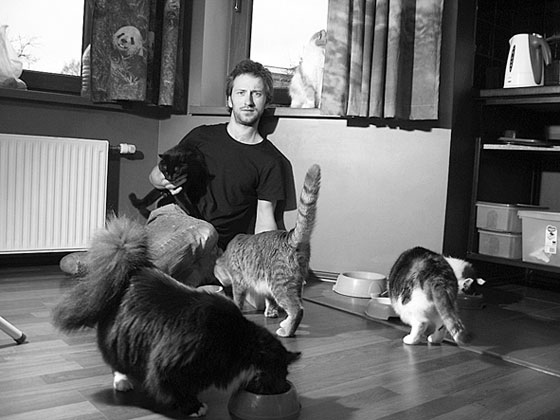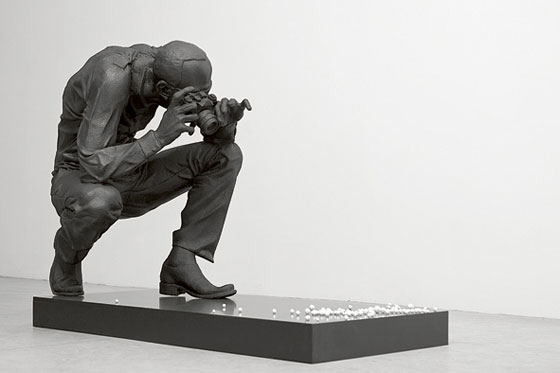|
|
| “I am the most unknown artist” Elīna Dūce, Visual Arts Theorist A two-part conversation with artist Ginters Krumholcs | |
| In recent years, in exhibition spaces one relatively rarely sees newly-created, un-stylized, realistic images based on life studies. Whether it’s the remnants of Soviet doctrine still haunting our collective subculture, or some other weakness, the fact remains that fleeing from realism towards abstraction is currently the mainstream in the visual arts. But then late last year, the “most unknown artist” – as he jokingly calls himself – held his first solo exhibition (actually the very first one took place in 2003) called Mayday!, in which the sculptural works draw the attention due to their careful study of the human anatomy. Far from being obscure, Ginters Krumholcs is well-known and first attracted attention among artistic circles while still a student at the Latvian Academy of Art. In 2001, when he was a second year student, his sculpture A Gift for the Next Millennium was installed in the town of Valmiera. In Riga’s urban environment, Empire (2007), created as part of the Republic of Speķa Street art project, can be seen in a tunnel in the gritty suburb of Maskačka. A few years ago, Ginters and his wife, painter Mārīte Guščika, set up studios in the same building. We are met there by the two and their six cats. They tell stories about dozens of other felines they have found, nurtured back to health, fed or brought down from trees to live with them or in some other new home. | |
 Ginters Krumholcs. 2012 Photo from the private archive of Ginters Krumholcs | |
| Ginters Krumholcs: In Latvia cats are simply tossed out the door. Then they breed and nobody wants anything more to do with them. The friendly ones are those that were thrown out of home. You see it in the streets and the shelters – there are the savages that stare at you, then run away when you try to approach them, but the domesticated cats just follow you around like little eejits. Studija: You’re not working anywhere now? G.K.: I used to work in a design studio. We made all kinds of outdoor advertisements and interiors. I quit about three years ago. But it was a great experience, because I learned all about plastics and polymers and what you can do with them, how they react in sunlight and so on. That knowledge is useful to me now. Studija: So you’ve thrown yourself into art? G.K.: Yes, I like it that way. Making things for money, you always feel a certain lack of fulfilment. Time is rushing by, but you’re doing something you hate. As a result you end up doing chaotic, sloppy work, you simply don’t want to do it and then you start thinking of something else. That’s how I poked out my eye (points to his left eye). They stitched me up very well, but when I got out of hospital I knew that things couldn’t go on like that! No point in carrying on like that, I’d poke something else out. You shouldn’t spend your life chasing after meaningless stuff. I’ve wasted enough time doing things I don’t want to do. At first it was hard and I couldn’t create anything. I couldn’t see in three dimensions, so the side where my eye was missing I made bigger. Studija: When you have thought of something, do you go to the studio? G.K.: Yes, let’s go and have a look. Studija: Everything is so neat and tidy here! G.K.: I made the table. I can hit it with whatever I like and nothing will happen. I did all the tiling and plumbing too, and I’m planning to install a ventilation system, and lighting. And if I put up an awning I’ll be able to work outside in summer. Studija: With resin... That’s harmful isn’t it? G.K.: … (Someone is knocking at the workshop door) Mārtiņš is coming! He’s my friend and inspiration. I sculpted him for the Mayday! exhibition. Mārtiņš is my neighbour, a young entrepreneur. It seemed to me that he was the embodiment of David. But he doesn’t go into battle with a slingshot – he uses a hairdryer, because in business you have to be the most beautiful, the smartest and the strongest. | |
 Ginters Krumholcs. 4:25 AM. Fibreglass. 96x60x130 cm. 2011 Photo: Renārs Derrings | |
| Studija: What else was in the exhibition? G.K.: August 14, the start of the duck shooting season. That green guy in the reeds. Studija: He looks like you. G.K.: I don’t know who he is similar to. I once watched how Aigars (sculptor Aigars Bikše – E. D.), a balding, bearded man, was eating an egg and I saw in it a male fetish: the beard as a nest and the egg as a symbol. This caught my imagination and I started creating the image without a model. My policy is that everything I create with clothes on first gets produced naked, because I don’t want to tell any lies. Studija: You make everything out of clay first? G.K.: Yes. Then I take a plaster cast. See, here’s “Mārtiņš’” head (pointing). First you make a positive and then a negative plaster cast. I work out the details first, because later on, in the resin, it’s difficult to do. I make a silicon mould and then glue in that polyester resin. After that I apply stucco, polish, blow some stucco on, do some drying, polish again, then repeat the process about ten times. Finally I paint and lacquer. I loathe texture. It’s a sign of laziness and carelessness. Maybe there are places that need it, but from start to finish I don’t like leaving anything to chance. I polish the figures for months. Sort of meditatively. I have the illusion that everything must be perfect. It isn’t easy to forge a single form from over a dozen pieces, because the plaster itself shifts when you dismantle it. So for six months I did nothing but work on the three pieces for the exhibition. When I ran out of money for materials and living, I called my relatives, and at times like that you understand how important it is to have family support. And as for that resemblance… If you don’t want to lie and you don’t have any visual aids handy, you just grab a mirror and get to work. Studija: You also had an exploded man in the exhibition (Balstīts uz patiesiem notikumiem [‘Based on a True Story’], 2009). G.K.: That’s an earlier work. I don’t like it anymore. Here’s the wooden camera I used to make the “photographer’s” fingers (04:25 AM, 2011). In sculpture it’s complicated to create things standing in front of each other. Studija: How did you come up with the “photographer”? G.K.: I have the feeling that he is snapping pictures of the evidence. The theme of the Mayday! exhibition was the inner prayers of men. What each of us quietly does every day in order to succeed. I get annoyed when works are given a literary flavour. Studija: That the story is invented? G.K.: Yes. My works are simply a feeling. Studija: Brief moments. G.K.: Exactly. I don’t like works that are based on some found story. I think that the little things, movements, coincidences that you see are packed with information, not just about what is happening right now but also about – how to put it… the big picture, the big feeling. | |


| |
| Studija: What’s that you’ve got there? G.K.: Those psychopaths in suits? That’s the series Based on a True Story I made in 2010. I wanted to be a slightly social artist. That was that crazy time when the well-dressed, beautiful thieves and psychopaths brought the country down to where it is. Actually, I started making men in suits a long time ago. Zvejnieka dēls [‘The Fisherman’s Son’] (2007) was one of my first works and now it’s in the exhibition of Belēvičs’ collection. I made three final versions of Balstīts uz patiesiem notikumiem [‘Based on a True Story’]: with a bag over its head, with a shark’s jaws and an exploded head. There wasn’t much room in the studio so I made them small. It was hard to escape from the subject. I looked for solutions over and over; I was a bit bogged down. Studija: And what are you doing now? G.K.: Making some furniture. One thing that I don’t like about sculpture is that it requires a lot of physical strength, which I don’t have. If I worked with granite, I’d be dead. Studija: Why don’t you make anything out of sand or ice? G.K.: Why don’t you make pictures of glued up bits of amber? You know, some people think that the sand sculpture that was on show at AB dambis in Riga was really amazing, that it was sculpture … Elves, rabbits and dinosaurs... That’s craft, not art. The sculptors who do it probably approach it as professionals, they simply see it as business. But I’ve never done it, and never will, no matter how hard things get. Studija: But many people work in that field. G.K.: And they’ve stayed there. I hate it when art starts to get vulgar. Problems are artificially found and then artificially solved. Generally I get annoyed by the culture of projects, even though, possibly, that may be the best way to do things. But judging by my colleagues’ recent activities, 2011 was the year of sculpture. I haven’t seen so much going on in sculpture in a long time. Gļebs Panteļejevs, Aigars Bikše and Ivars Drulle all had exhibitions, I did as well. There’s no longer the same vacuum that there was a few years ago, when there were only a few projects around, and even those were installations. Now you can observe a sculpture renaissance. Studija: Did you have any idols while you were at the academy? G.K.: Actually Andris Vārpa has been my biggest influence. He dragged me into sculpture, and now that I’m working in sculpture I remember the ideas he taught me. Studija: At that time you were living in Valmiera? G.K.: Yes. Afterwards for a few years I kept going to Vārpa’s place to work. That was the time he was making Irbīte and Padegs. He taught me a great deal that I didn’t understand at the time, but now when I am creating I remember it, because when you have a formal problem you look for help, and then while you are “rewinding the film” Vārpa’s wise words pop out from who knows where. Aigars Bikše also encouraged me towards slightly broader thinking about ideas during my time at the academy. I’m not saying that I’m mature, but I’ve learned some maturity in composition and ideas from my wife. In general I’m very chaotic. Thoughts whirl around in my head and sometimes I could really mess things up, but my wife helps me get back to my initial idea and get rid of the superfluous. And really I consider that I have only been alive for ten years. I am a ten year young person. Ginters Krumholcs was born in 1980, in Valmiera. He graduated with a Master’s degree from the Art Academy of Latvia sculpture department (2007). Solo exhibitions: The First (2003, Laipa Gallery, Valmiera), Mayday! (2011, Māksla XO Gallery, Riga). Group exhibitions: Republic of Speķa Street (2007, Riga urban environment), The Train Hasn’t Left Yet (2010, Bulduri Railway Station), Dense Space (2011–2012, Latvian National Museum of Art exhibition hall Arsenāls, Riga), Is it that He does not Seek the Truth, But Does Want to Influence? (2011–2012, Riga Art Space) and others. Nominated for the Latvian Art Academy award and Purvitis award in 2011. /Translator into English: Filips Birzulis/ | |
| go back | |







